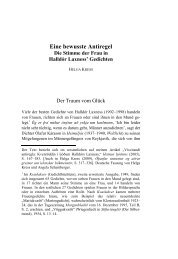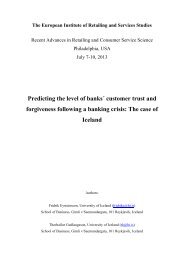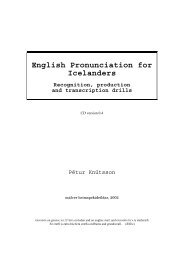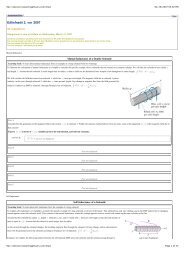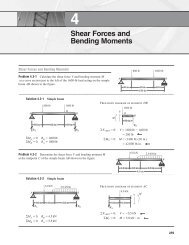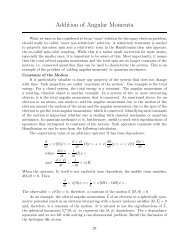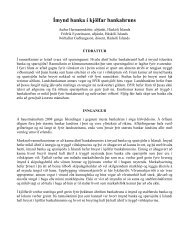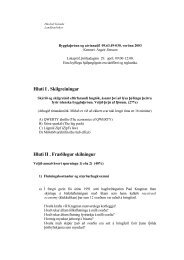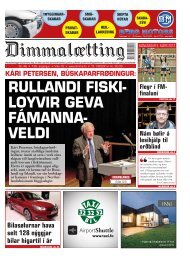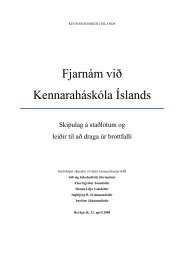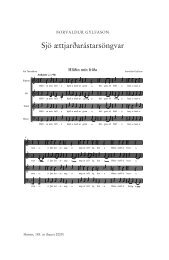The Hartree-Fock approximation underlies the most commonly used ...
The Hartree-Fock approximation underlies the most commonly used ...
The Hartree-Fock approximation underlies the most commonly used ...
You also want an ePaper? Increase the reach of your titles
YUMPU automatically turns print PDFs into web optimized ePapers that Google loves.
This is a matrix representation of <strong>the</strong> <strong>Hartree</strong>-<strong>Fock</strong> equation and is called <strong>the</strong> Roothaan<br />
equations. <strong>The</strong> matrices ˜ F, ˜ S and ˜ C are K × K matrices and ¯ǫ is a vector of length K.<br />
<strong>The</strong> problem is <strong>the</strong>refore reduced to solving algebraic equations using matrix techniques.<br />
Only if K → ∞ are <strong>the</strong> Roothan equations equivalent to <strong>the</strong> <strong>Hartree</strong>-<strong>Fock</strong> equation.<br />
<strong>The</strong> Roothaan equations are non-linear:<br />
˜F ( ˜ C) ˜ C = ˜ S ˜ C¯ǫ.<br />
Since ˜ F depends on ˜ C and <strong>the</strong>refore <strong>the</strong>y need to be solved in an iterative fashion. Given<br />
an estimate for ˜ Cn we can find an estimate for ˜ F ( Cn) ˜ and <strong>the</strong>n solve <strong>the</strong> equation<br />
˜F ( ˜Cn) ˜ Cn+1 = ˜ S ˜ Cn+1¯ǫ<br />
to obtain a new estimate for <strong>the</strong> ˜ C matrix. If ˜ Cn+1 = ˜ Cn to within reasonable tolerance<br />
<strong>the</strong>n self consistency has been achieved and ˜ Cn is <strong>the</strong> solution. Most workers refer to such<br />
a solution as self-consistent-field (SCF) solution for any finite basis set {φi} and reserve<br />
<strong>the</strong> term <strong>Hartree</strong>-<strong>Fock</strong> limit to <strong>the</strong> infinite basis solution. <strong>The</strong> equation is solved at each<br />
step by diagonalizing <strong>the</strong> overlap matrix ˜ S, i.e., by finding a unitary transformation ˜ X<br />
such that<br />
X † SX = 1.<br />
<strong>The</strong> transformed basis function are<br />
φ ′ µ = <br />
and form an orthonormal set, i.e.,<br />
γ<br />
<br />
Xγµφγ<br />
drφ ′∗ µ φ′ γ<br />
µ = 1, 2, . . ., K<br />
= δµγ.<br />
<strong>The</strong>n <strong>the</strong> equation becomes an ordinary eigenvalue equation:<br />
F ′ C ′ = C ′ ǫ where F ′ ≡ X † FX and C ′ ≡ X −1 C.<br />
<strong>The</strong> main computational effort in doing a large SCF calculation lies in <strong>the</strong> evaluation of<br />
<strong>the</strong> two-electron integrals. If <strong>the</strong>re are K basis functions <strong>the</strong>n <strong>the</strong>re will be on <strong>the</strong> order<br />
of K 4 /8 unique two-electron integrals. This can be on <strong>the</strong> order of millions even for small<br />
basis sets and moderately large molecules. <strong>The</strong> accuracy and efficiency of <strong>the</strong> calculation<br />
depends very much on <strong>the</strong> choice of basis functions, just as any variational calculation<br />
depends strongly on <strong>the</strong> choice of trial functions.<br />
Basis Set Functions:<br />
Two types of basis functions are frequently <strong>used</strong>:<br />
42



